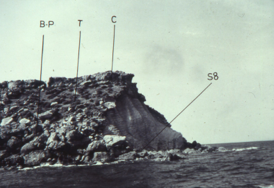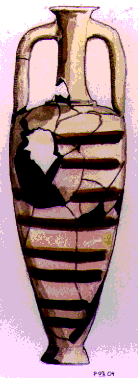Department of Antiquities
Source - http://www.moi.gov.cy/moi/pio/pio.nsf/All/B4E8E30DE8643CF2C2257A540028E5A9?OpenDocument
The Ministry of Communications and Works, Department of Antiquities, announces the completion of five weeks of excavation at the island of Geronisos by the New York University Geronisos Island Expedition. The excavations were under the direction of Professor Joan Breton Connelly. Geronisos, “Holy Island,” was an important place of pilgrimage during the late Hellenistic period when worshippers crossed the waters to pray at its sanctuary of Apollo.

Here, a series of small amulets that may have been worn by toddler boys brought to Geronisos to mark their transitional time of weaning, have been recovered. That these amulets were made on Geronisos is suggested by the discovery, this season, of an unfinished charm, not yet pierced for suspension and not yet engraved with designs. One recently discovered amulet is inscribed with male names: Minas, written along the side, and Diophantes, written on the bottom. These may represent the names of boys who wore the talisman during special rites on Geronisos.
An ostrakon recovered from the site similarly lists male names: Chariton, Thrasayes, Nikkon and Xaireas. These are, perhaps, the names of boys who participated in the maturation rituals. Still other ostraka preserve the writing exercises of children practicing their Greek letters. These suggest that a school for boys may have been part of the sanctuary. A circular platform unearthed at the north side of Geronisos seems to be a dance floor, the setting for boys’ choral dancing, an integral part of their education and a means to please the god Apollo.
Late Hellenistic pottery excavated this season includes drinking cups, bowls, juglets, lagynoi and plates in Eastern sigillata A fabric, Cypriot Sigillata and our own local Pink Powdery Ware.

Ongoing erosion by sea and wind and earthquake tremors endanger the foundations of buildings set on the edges of Geronisos. Accurate recording and mapping of the foundations are urgently needed. Architect Richard Anderson has worked this season to prepare a new 3-D digital state plan using a laser theodolite total station (Fig. 5). Dr. Paul Croft of the Lemba Archaeological Field Station trained students participating in the Geronisos Island Field School and reconsolidated the southern terrace walls of Geronisos.
Elizabeth Williams of the New York University’s Institute of Fine Arts and the Metropolitan Museum of Art participated in the study of the Early Byzantine material from Geronisos. Talia Varonas-Pavlopoulou and Brett Wisniewski of NYU’s Department of Classics, specialists in Greek drama and in magical inscriptions, joined the team as well. Stella Diakou of Nicosia and Pegeia, a PhD candidate in Classical Archaeology at Bryn Mawr College, excavated with the NYU team. The project’s new website has been launched at www.yeronisos.org.